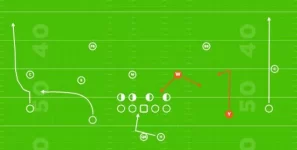Since I promised this would be the last RPO thread I won't start a new one, but I wanted to briefly outline some ideas about how various aspects of the RPO concept are used successfully at other schools, and what elements would translate well to our offense with the athletes we have now and in the future. Caveat as always - I'm not a coach, not a former player. I'm just a guy with a keyboard who nerds out over stuff like this so any additions, corrections, or revisions are always welcome.
So, as explained above, the essence of the RPO concept is of course the Run-Pass Option. In other words, the QB comes to the line with a play that has two possible outcomes - a run, or a pass. The QB reads the defense both pre- and post-snap and looks for what's called a "conflict defender" - this is the guy on defense that has to make the decision to play the run or the pass. Often it's a LB, but not always (more on that later.) For example if the conflict defender is in the box playing the run, the QB can hit a quick slant or screen to where he was. Conversely, if the conflict defender is playing off, he can hand the ball off (or run it himself.)

In this pic we can see the Will LB is the conflict defender. At the snap, the QB reads him - if he cheats up to play the run, the QB can throw to the Y WR running the hitch. If he backs into zone, he can hand it to the RB.
Here's a video outlining a slant/middle RPO concept:
[video=youtube;3IwjsAJkPPU]https://www.youtube.com/watch?v=3IwjsAJkPPU[/video]
Note the first clip of this play is UGA with Aaron Murray.
Here's another video from raining FCS Champion (and my Alma Mater) JMU on their Power RPO/bubble concept:
[video=youtube_share;5G0fdcb0JwM]https://youtu.be/5G0fdcb0JwM[/video]
Where this gets fun is that the RPO can be expanded and built on from the simple "handoff or hitch" philosophy to include multiple pass-catching options and QB runs. Essentially, it builds off of the age-old concept of multiple play options from a single formation, so the personnel never dictates the playcall. Here's an article I found on Ole Miss (back in 2013 when Ole Miss was good) about a play they ran 5 times with four different options:
Packaged Plays and the Newest Form of Option Football «
Another place it gets fun (and this is where some of the confusion comes in) is when you add a QB's ability to tuck and run into the equation. Clemson and Louisville both add this dimension to the RPO with great success:
[video=youtube_share;HCWPNz6n8t4]https://youtu.be/HCWPNz6n8t4[/video]
Notice in this video the far-side screen/bubble WR. After the play-fake to the RB (the first read), the QB slides left. If that "conflicted" LB had crashed down on the playaction or backed into zone, Watson could turn it up and run. Instead, the LB is playing the QB run all the way, leaving the WR wide open with two blocking WRs to help.
The RPO can be run with the primary pass-catching option as a WR, but also with the TE or H-Back:
[video=youtube_share;dh5NJakk0R0]https://youtu.be/dh5NJakk0R0[/video]
Notice here the MLB crashing the middle to take away the inside zone. Watson again slides left and sees the other LB staying home to take away the QB run. He then simply drops it over his head to the H-Back for a nice gain. With the added element of QB runs, the RPO system adopts many of the precepts of the triple-option, only with a more "spread" philosophy.
Here's another RPO from Louisville that highlights the H-Back:
[video=youtube_share;DHYpOmk-UhY]https://youtu.be/DHYpOmk-UhY[/video]
Notice also the down and distance here - 3rd and 1. Shotgun, Power look (HB, FB, and H-Back all in the backfield.) Defense logically crashes down and the H-back sneaks out for big yardage - no need to line up in the Coker T. If the defense had been spread out all game long, perhaps they don't stack the box and Jackson could have just handed off to the RB for the needed yardage (or kept it on the edge if the DE had crashed inside.)
So how can/should Mark Richt integrate the RPO into Miami's offense? We already know he's installed many of the elementary single-read "handoff or pass" elements a la App State last year. As you can see above, while the basic RPO doesn't inherently require a "running QB", with the added dimension of at least the THREAT of a QB keep, many other options become available.
Imagine a basic 1st down setup: Rosier/Perry/QB of choice, Walton at RB, Herndon at H-back, AR at the X, Mullins at the Y, Dallas at the Z (for argument's sake.) From this personnel package could come any number of zone/power runs, hitches, bubbles, or slants to the slot or outside, even motion/jet sweeps to Deejay or Mullins depending on where the defense has been trending.
I'd wager most defenses this year will be ****-bent on stopping Walton and making whoever our new QB is beat them with his decision-making. The RPO is a great way to give any QB simple reads and one or two things to think about post-snap. Maybe we start out running those endless bubble screens to the outside to tighten up the DBs then go over the top or run a sluggo later in the game. Or maybe we work the inside slant/dig game to loosen up the LBs, mixed in with inside zone-reads to Walton to keep the defense guessing.
These are just initial thoughts - as always, I'm always up for discussion/correction!
